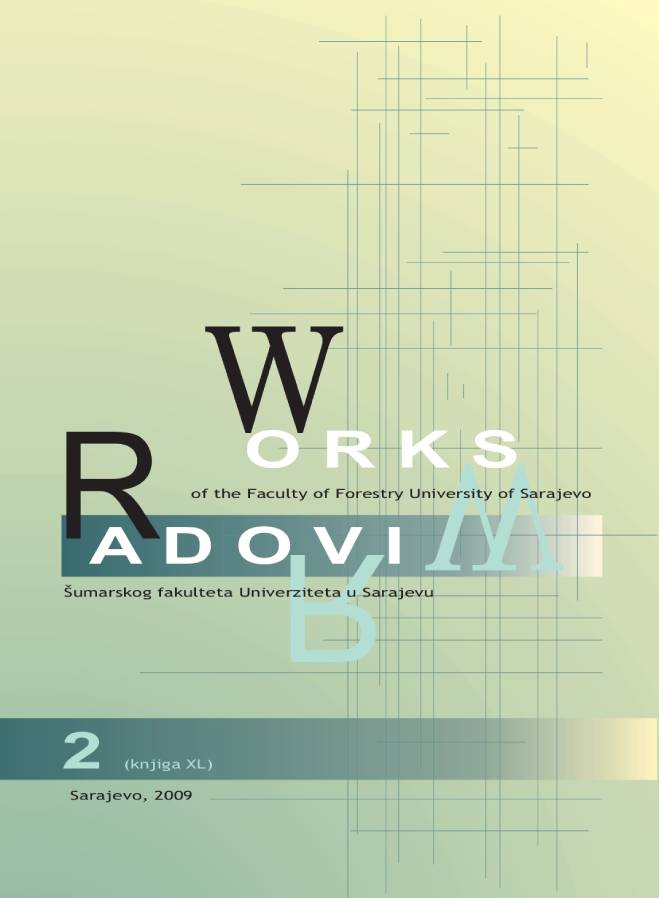Vegetation characteristics and diversity of coppice beech forests in the Canton of Sarajevo
DOI:
https://doi.org/10.54652/rsf.2009.v39.i2.159Keywords:
beech coppice, vegetation characteristics, diversity, Canton of Sarajevo, B&HAbstract
UDK 630*222:582.632.2(497.6 Sarajevo)
581.92:582.632.2(497.6 Sarajevo)
In Bosnia and Herzegovina, the largest areas of all coppice forest have coppice beech forests, and their size is about 17% of all forests and forest lands. Floristic - vegetation characteristics and low diversity of beech forests is little explored. For this paper we analyzed the vegetation characteristics and diversity coppice beech forests in the Canton of Sarajevo. For the purposes of this analysis placed the 58 experimental surfaces at neutral and acid soils – distric cambisol. On this plots we collected floristic and ecologic data’s e.g.: type of soils, altitude, slope, canopy cover, cover of ground flora... Our research shows that differences in diversity index and evenness, is very small and not statistically significant between the coppice beech forests in distric cambisol and coppice beech forests in the soil, which are marked as neutral. Not the existence of differences in ground flora biodiversity can be explained by similar development of coppice beech forests in the investigated soils. Namely, after the "clear cutting" shoots from the stump accession intensively and quickly assembled and thus prevented the development of any other vegetation, and is particularly difficult the development of forest ground flora. Further development of coppice beech forest begins to occur and the ground flora, but significantly changed compared to primary forests as well as different quantitative traits. Only when we fully achieve the structural similarity of: canopy, height, diameters ... as well as in the original forests of beech, or when it updates the original stand conditions can be expected to restore the characteristic ground flora of appropriate habitat. The appearance of similarity ground flora between the tested groups, or not the existence of the separation characteristic and differential species , show us that coppice forests should not be classified syntaxonomic hierarchical system, at least as structurally and physiognomic become such a high beech forest.
References
BALIĆ, B., VOJNIKOVIĆ, S., VIŠNJIĆ, Ć., MUSIĆ, J. (2006): Osnovni proizvodni
pokazatelji i strukturna izgrađenost izdanačkih šuma bukve na području KS. Simpozij IV poljoprivrede, veterinarstva, šumarstva i biotehnologije, Zenica (Abstract).
BEUS, V. (1984): Vertikalno raščlanjenje šuma u svijetlu odnosa realne i primarne vegetacije u Jugoslaviji; ANUBiH, Radovi LXXVI, knj. 23, Sarajevo, pp. 23-32.
ĆIRIĆ M., STEFANOVIĆ, V., DRINIĆ, P. (1971): Tipovi bukovih šuma i mješovitih šuma bukve, jele i smrče u BiH. Šumarski fakultet i Institut za šumarstvo i drvnu industriju u Sarajevu, Posebna izdanja br. 8., str. 1-230, Sarajevo.
DIACI, J., ROŽENBERGAR, D., MIKAC, S., ANIĆ, I., HARTMAN, T., BONČINA, A.
(2007/08):Long-term changes in tree species composition in old-growth Dinaric beech-fir forest; Glasnik za šumske pokuse. 42, 1; Zagreb, pp.13-28.
ĐIKIĆ, S., KOLAKOVIĆ, R. 1965: Osnovi za proizvodno ekološku klasifikaciju zapustenih i degradiranih panjaca u Bosni i Hercegovini. Radovi Šumarskog fakulteta i Instituta za Šumarstvo Sarajevo, Posebno izdanje.
KORIČIĆ, Š. (2005): Biološki, ekološki i ekonomski pokazatelji uspješnosti proreda u panjačama bukve. Doktorska disertacija (mnsc). Šumarski fakultet Sarajevo.
KREBS, J. C. (1999): Ecological Methodology – Second Edition; Addison Wesley Longman, Inc. New York.
LEPŠ, J., ŠMILAUER, P. (2002): Multivariate analysis of ecological data using CANOCO; Faculty of Biological Sciences, University of South Bohemia, (mnsc.), Česke Budejovice.
RAKONJAC, LJ, NOVAKOVIĆ, M. (2005): Fitocenološke karakteristike izdanačkih bukovih šuma. eds.: Krstić, M.; Koprivica, M., Rakonjac, Lj.: „Izdanačke bukove šume severoistočne Srbije“; Monografija - Šumstrski fakultet Beograd, str.: 38-45, Beograd.
STEFANOVIĆ, V. (1964): Šumska vegetacija na verfenima pješčarima i glincima istočne i jugoistočne Bosne; Radovi Šum. fak. i Inst. za šum. i drv. indust. u Sarajevu, God. IX, Knj. 9. Sv. 3., Sarajevo.
STOJANOVIĆ, O., IZETBEGOVIĆ, S., KOPRIVICA, M., LAZAREV, V., LUTERŠEK, D., MEKIĆ, F., PAVLIČ, J., PINTARIĆ, K., STEFANOVIĆ, V. (1986): Ekološko-proizvodne karakteristike (proizvodni potencijal), dugoročni ciljevi i mogućnosti proizvodnje drveta, na staništima izdanačkih šuma bukve u SR BiH. Šumarski fakultet; Naučno istraživački projekat (mnsc.), str.1-120., Sarajevo.
SUCHOMEL C.& KONOLD W. (2008): Niederwald als Energiequelle – Chancen und Grenzen aus Sicht des NaturschutzesBer. Naturf. Ges. Freiburg i. Br., 98, S. 61 - 120, Freiburg.
WEBER, H.E., MORAVEC, J., THEURILLAT, J-P. (2000): Međunarodni kodeks fitocenološke nomenclature. Journal of Vegetation Science 11, Opulus Press, pp. 739-768,


















